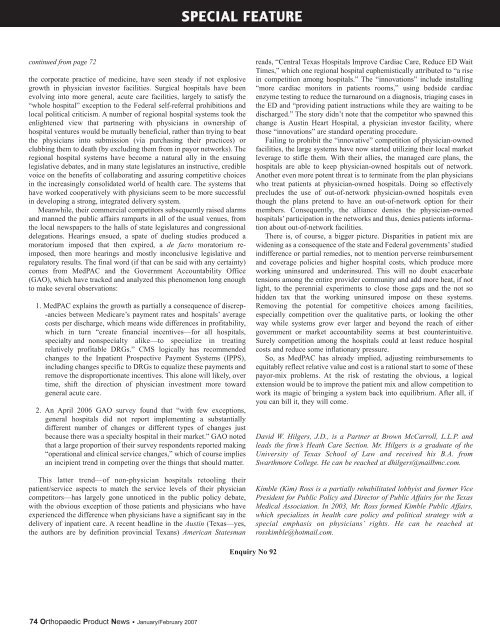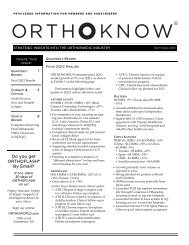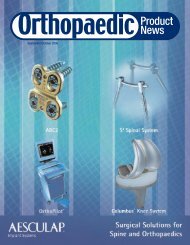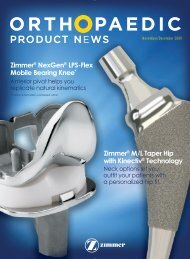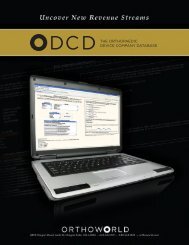AAOS, Arthroscopy - Orthoworld
AAOS, Arthroscopy - Orthoworld
AAOS, Arthroscopy - Orthoworld
Create successful ePaper yourself
Turn your PDF publications into a flip-book with our unique Google optimized e-Paper software.
SPECIAL FEATUREcontinued from page 72the corporate practice of medicine, have seen steady if not explosivegrowth in physician investor facilities. Surgical hospitals have beenevolving into more general, acute care facilities, largely to satisfy the“whole hospital” exception to the Federal self-referral prohibitions andlocal political criticism. A number of regional hospital systems took theenlightened view that partnering with physicians in ownership ofhospital ventures would be mutually beneficial, rather than trying to beatthe physicians into submission (via purchasing their practices) orclubbing them to death (by excluding them from in payor networks). Theregional hospital systems have become a natural ally in the ensuinglegislative debates, and in many state legislatures an instructive, crediblevoice on the benefits of collaborating and assuring competitive choicesin the increasingly consolidated world of health care. The systems thathave worked cooperatively with physicians seem to be more successfulin developing a strong, integrated delivery system.Meanwhile, their commercial competitors subsequently raised alarmsand manned the public affairs ramparts in all of the usual venues, fromthe local newspapers to the halls of state legislatures and congressionaldelegations. Hearings ensued, a spate of dueling studies produced amoratorium imposed that then expired, a de facto moratorium reimposed,then more hearings and mostly inconclusive legislative andregulatory results. The final word (if that can be said with any certainty)comes from MedPAC and the Government Accountability Office(GAO), which have tracked and analyzed this phenomenon long enoughto make several observations:1. MedPAC explains the growth as partially a consequence of discrep--ancies between Medicare’s payment rates and hospitals’ averagecosts per discharge, which means wide differences in profitability,which in turn “create financial incentives—for all hospitals,specialty and nonspecialty alike—to specialize in treatingrelatively profitable DRGs.” CMS logically has recommendedchanges to the Inpatient Prospective Payment Systems (IPPS),including changes specific to DRGs to equalize these payments andremove the disproportionate incentives. This alone will likely, overtime, shift the direction of physician investment more towardgeneral acute care.2. An April 2006 GAO survey found that “with few exceptions,general hospitals did not report implementing a substantiallydifferent number of changes or different types of changes justbecause there was a specialty hospital in their market.” GAO notedthat a large proportion of their survey respondents reported making“operational and clinical service changes,” which of course impliesan incipient trend in competing over the things that should matter.This latter trend—of non-physician hospitals retooling theirpatient/service aspects to match the service levels of their physiciancompetitors—has largely gone unnoticed in the public policy debate,with the obvious exception of those patients and physicians who haveexperienced the difference when physicians have a significant say in thedelivery of inpatient care. A recent headline in the Austin (Texas—yes,the authors are by definition provincial Texans) American Statesmanreads, “Central Texas Hospitals Improve Cardiac Care, Reduce ED WaitTimes,” which one regional hospital euphemistically attributed to “a risein competition among hospitals.” The “innovations” include installing“more cardiac monitors in patients rooms,” using bedside cardiacenzyme testing to reduce the turnaround on a diagnosis, triaging cases inthe ED and “providing patient instructions while they are waiting to bedischarged.” The story didn’t note that the competitor who spawned thischange is Austin Heart Hospital, a physician investor facility, wherethose “innovations” are standard operating procedure.Failing to prohibit the “innovative” competition of physician-ownedfacilities, the large systems have now started utilizing their local marketleverage to stifle them. With their allies, the managed care plans, thehospitals are able to keep physician-owned hospitals out of network.Another even more potent threat is to terminate from the plan physicianswho treat patients at physician-owned hospitals. Doing so effectivelyprecludes the use of out-of-network physician-owned hospitals eventhough the plans pretend to have an out-of-network option for theirmembers. Consequently, the alliance denies the physician-ownedhospitals’ participation in the networks and thus, denies patients informationabout out-of-network facilities.There is, of course, a bigger picture. Disparities in patient mix arewidening as a consequence of the state and Federal governments’ studiedindifference or partial remedies, not to mention perverse reimbursementand coverage policies and higher hospital costs, which produce moreworking uninsured and underinsured. This will no doubt exacerbatetensions among the entire provider community and add more heat, if notlight, to the perennial experiments to close those gaps and the not sohidden tax that the working uninsured impose on these systems.Removing the potential for competitive choices among facilities,especially competition over the qualitative parts, or looking the otherway while systems grow ever larger and beyond the reach of eithergovernment or market accountability seems at best counterintuitive.Surely competition among the hospitals could at least reduce hospitalcosts and reduce some inflationary pressure.So, as MedPAC has already implied, adjusting reimbursements toequitably reflect relative value and cost is a rational start to some of thesepayor-mix problems. At the risk of restating the obvious, a logicalextension would be to improve the patient mix and allow competition towork its magic of bringing a system back into equilibrium. After all, ifyou can bill it, they will come.David W. Hilgers, J.D., is a Partner at Brown McCarroll, L.L.P. andleads the firm’s Heath Care Section. Mr. Hilgers is a graduate of theUniversity of Texas School of Law and received his B.A. fromSwarthmore College. He can be reached at dhilgers@mailbmc.com.Kimble (Kim) Ross is a partially rehabilitated lobbyist and former VicePresident for Public Policy and Director of Public Affairs for the TexasMedical Association. In 2003, Mr. Ross formed Kimble Public Affairs,which specializes in health care policy and political strategy with aspecial emphasis on physicians’ rights. He can be reached atrosskimble@hotmail.com.Enquiry No 9274 Orthopaedic Product News • January/February 2007


